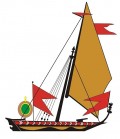Флот Імперії Маратха

The Maratha Navy refers to the naval wing of the armed forces of the Maratha Empire, which existed from around mid-17th century to mid-18th century in India.
In medieval India, the Muslim rulers (such as the Deccan Sultanates and Mughal Sultanate) had mostly ignored the naval arm of their military forces. It may be because they came overland from the North and won decisively in land battles. This scenario changed, however, when the Portuguese arrived in India and started monopolizing and controlling trade on the western coast of the continent. Chhatrapati Shivaji realized the importance of a strong navy; the first keel of a Maratha naval vessel was laid down in a creek near Kalyan circa 1654.
Shivaji took up the task of constructing multiple naval bases along the coast of present-day Maharashtra. He organized two fleets – one under the command of Admiral Mainak Bhandari and the other under Daulet Khan. The Maratha Navy consisted mostly of native Konkani sailors; however, it was commanded mostly by mercenaries, including Siddi and Portuguese. Circa 1659, the Maratha Navy consisted of around 20 warships. Hiring mercenaries was relatively common in Maratha military culture and the Navy was no exception to this practice. Portuguese naval officer Rui Leitão Viegas was hired as fleet commander, in part because the Maratha wanted to get insight into the Portuguese naval technology and capabilities. The Maratha knew the Portuguese had a powerful navy. The Portuguese convinced their mercenary officers to leave the service of the Maratha; however, the Portuguese allied with the Maratha when the latter went to war against the Mughal.
The Battle of Surat of 1664 was a well-coordinated one, whereby the Maratha used their Army and Navy in a coordinated way. In 1679, Shivaji annexed the island of Khanderi, which was 11 miles off the entrance to Mumbai. In response the English and the Siddi repeatedly attacked the island, but they were unable to oust the Maratha from the islands. It was a stark reminder for the British, the Portuguese, and the Mughals that Shivaji was not only powerful on land, but was equally powerful at sea.
Circa 1674, during Shivaji's coronation, the Portuguese at Goa noted and acknowledged the Maratha naval power and sent their emissary to Shivaji with gifts; they signed a treaty of friendship. Around this time, the Maratha Navy's strength was around 5,000 men and 57 warships. During its expedition to Karwar (present-day Karnataka), the navy possessed around 85 assorted Gallivats (warboat) ranging from 30 to 150 tons and 3 three-masted Gurabs/Grabs (warship).
Under Admiral Kanhoji Angre
After the death of Admiral Sidhoji Gujar around 1698, the Maratha Navy survived because of the extensive efforts of Admiral Kanhoji Angre. Under his leadership, the British naval power was checked along the western coast of India. Kanhoji owed allegiance to supreme Maratha ruler Chhatrapati Shahu and his first minister Peshwa Balaji Vishwanath. He gained their support to develop naval facilities on the western coast of India, or Konkan. Under the leadership of Kanhoji, the Maratha developed a naval base at Vijayadurg featuring dockyard facilities for building vessels, mounting guns, and making the ships sea-worthy. Their naval fleet consisted of ten gurabs/grabs (warship) and fifty gallivats (warboat). A gallivat had a displacement lower than 120 tons, while a grab could go as high as 400 tons.
Another ship type used was the Pal (Maratha Man-of-war), which was a cannon-armed, three-masted vessel. The grabs had broadsides of 6- and 9-pounder guns, and carried two 9- or 12-pounders on their main decks. These guns pointed forward through port-holes cut in the bulkheads. The gallivats were mostly armed with light swivel guns, but some also mounted six or eight cannons, either 2- or 4-pounders. These boats were propelled by forty to fifty oars. Even during the reign of Kanhoji Angre, the Maratha Government signed a treaty of friendship with the Portuguese in 1703. As per the treaty, the Portuguese agreed to supply cannon and gunpowder to the Maratha, supplies which they needed as they had only a few cannon foundries producing their own armaments. The Marathas signed a treaty with the Siddi as well, thus concentrating all their forces against the English East India Company.
By the beginning of the 18th century, Kanhoji Angre controlled the entire coastline from Sawantwadi to Mumbai, which is the entire coastline of present-day Maharashtra. He built fortifications on almost all creeks, cove, and harbours, such as a fortress or citadel with navigational facilities. Any ship sailing through Maratha territorial waters was to pay a levy called Chouth, which expressed Angre's dominance. Between 1717 and 1720, the British made at least two attempts to defeat and destabilize the Maratha Navy, but were unsuccessful. In response to a British ship being captured by Kanhoji's seamen, the British attacked Vijayadurg and Khanderi, but they did not defeat them. The Maratha Navy repeatedly proved its strength against foreign powers. Till his death in 1729, Angre remained undefeated, despite repeated attacks by British and Portuguese.
Decline
By the mid 1700s, especially when compared to the British Navy, the Maratha Navy declined rapidly. Unlike Kanhoji Angre, his successor Admiral Tulaji Angre resisted the authority of the ruling Peshwa (the de facto chief or the First Minister of Maratha Empire). The Peshwas (under Nanasaheb) (in concert with the British) engaged in a war against Tulaji, in which the British managed to get an opportunity to burn and destroy a portion of the Maratha naval fleet. The Peshwas tried to reconfigure and re-establish the navy under the leadership of the Dhulap family, but the Navy could never regain its past glory. The British were able to exploit the declining Maratha Navy during the First Anglo-Maratha War. Through 1760s and 1780s, the Maratha Navy was commanded by Rudraji Dhulap and by Anandrao Dhulap. In the late 1700s, whenever the Marathas were engaged in battles or conflicts with either the English or Haider Ali of Mysore, the Maratha Navy undertook operations against enemy ships. In 1818, after the end of the third and final Anglo-Maratha War, the Angre family became a vassal of the British however a small Angre state lingered on till 1840, post which it was finally annexed to British India.
- Коментарі
 uk
uk en
en ru
ru






